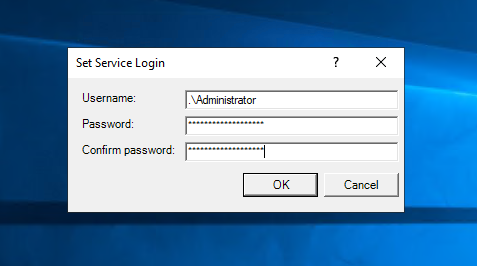
- Mongodb windows service auth driver#
- Mongodb windows service auth upgrade#
- Mongodb windows service auth password#
MongoCredential credential = MongoCredential.createMongoCRCredential(user, database, password) String database // the name of the database in which the user is defined To explicitly create a credential of type MONGODB-CR use the createMongCRCredential
Mongodb windows service auth upgrade#
If your deployment has user credentials stored in MONGODB-CR schema, you must upgrade to SCRAM before you upgrade to version 4.0.įor information on upgrading to SCRAM, see Upgrade to SCRAM. Starting in version 4.0, MongoDB removes support for the deprecated MongoDB Challenge-Response ( MONGODB-CR) authentication mechanism.

Using the new MongoClient API: MongoClient mongoClient = using the legacy MongoClient API: MongoClientURI uri = new mongoClient = new MongoClient(uri) Or use a connection string that explicitly specifies the authMechanism=SCRAM-SHA-1. MongoCredential credential = MongoCredential.createScramSha1Credential(user, source, password) To explicitly create a credential of type SCRAM-SHA-1, use the Or use a connection string that explicitly specifies the authMechanism=SCRAM-SHA-256. MongoCredential credential = MongoCredential.createScramSha256Credential(user, source, password) To explicitly create a credential of type SCRAM-SHA-256, use the Requires MongoDB 4.0 and featureCompatibilityVersion to be set to 4.0. MongoDB 4.0 introduced support for SCRAM-SHA-256 MongoDB 3.0 introduced support for SCRAM-SHA-1 which uses the SHA-1 hashing function. SCRAM isīased on the IETF RFC 5802 standard that defines best practices for implementation ofĬhallenge-response mechanisms for authenticating users with passwords. Salted Challenge Response Authentication Mechanism ( SCRAM) has been the default authentication mechanism for MongoDB since 3.0. Using the new MongoClient API: MongoClient mongoClient = using the legacy MongoClient API: MongoClientURI uri = new mongoClient = new MongoClient(uri) įor challenge and response mechanisms, using the default authentication mechanism is the recommended approach as it will make upgradingįrom MongoDB 2.6 to MongoDB 3.0 seamless, even after upgrading the authentication schema.įor MongoDB 4.0 users it is also recommended as the supported authentication mechanisms are checked and the correct hashing algorithm is Or use a connection string without explicitly specifying the authentication mechanism. Or using the legacy MongoClient API: MongoClient mongoClient = new MongoClient(new ServerAddress("host1", 27017), credential) Using the new (since 3.7) MongoClient API: MongoClient mongoClient = MongoClients.create(īuilder.hosts(Arrays.asList(new ServerAddress("host1", 27017)))) MongoCredential credential = MongoCredential.createCredential(user, source, password) Īnd then construct a MongoClient with that credential.
Mongodb windows service auth password#
String source // the source where the user is definedĬhar password // the password as a character array Static factory method: String user // the user name To create a credential that will authenticate using the defaultĪuthentication mechanism regardless of server version, create a In MongoDB 4.0 support for the deprecated In MongoDB 3.0, MongoDB changed the default authentication mechanism from MONGODB-CR to


MongoClient() constructor that takes a MongoClientURI parameter.

You can also use a MongoClientURI and pass it to a The MongoCredential class includes staticįactory methods for each of the supported authentication mechanisms. Legacy MongoClient API: import Īn authentication credential is represented as an instance of the New MongoClient API (since 3.7): import
Mongodb windows service auth driver#
The Java driver supports all MongoDB authentication mechanisms, including those only available in the


 0 kommentar(er)
0 kommentar(er)
